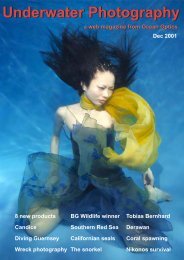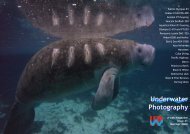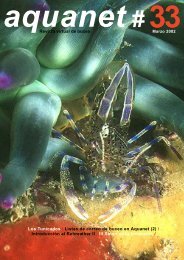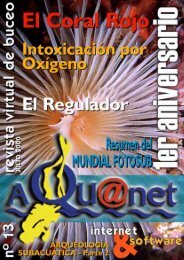Underwater Photography - SENSACIONES.org
Underwater Photography - SENSACIONES.org
Underwater Photography - SENSACIONES.org
Create successful ePaper yourself
Turn your PDF publications into a flip-book with our unique Google optimized e-Paper software.
not basic equipment and chose not to use them.<br />
Instead, deeper, we concentrated on monochrome<br />
images. <strong>Underwater</strong> images can look particularly<br />
striking in black and white, especially when you use<br />
the direction of the available light advantageously<br />
when composing the shot. In generally light<br />
underwater downwells from above. Often a slightly<br />
downward camera angle makes best use of ambient<br />
light to achieve even illumination of the subject.<br />
The Olympus has both Black and White and Sepiatoned<br />
monochrome modes, but if these features are<br />
not available their effect can be easily achieved<br />
afterwards in Photoshop.<br />
Behaviour<br />
The internal flash is only going to light up<br />
backscatter and not the main subject, so for wide<br />
angle it is best to shoot with only available light.<br />
Shooting in black and white is a good way to<br />
disguise the lack of colour! Olympus C220. 5mm<br />
lens. 1/60 th @ f2.8. Flash Off (GS).<br />
could get would be with available light.<br />
In shallow water (less than 5m) we found that<br />
the auto-white balance of the camera allowed us to<br />
produce reasonably colourful shots. We could have<br />
added coloured filters to help us take coloured<br />
images deeper than this, but we felt that filters were<br />
42<br />
One of the projects I was working on in Grand<br />
Cayman was photographing reef fish spawning,<br />
particularly that most Caribbean group of fish the<br />
Hamlets. I was keen to get as much time with the<br />
fish as possible so I did a deal with Giles: if he<br />
would waste a couple of Friday nights watching fish<br />
instead of hitting the apres SCUBA, I would come<br />
out for a beer later in my trip. Seemed like a good<br />
deal to me! Not many people have watched hamlets<br />
spawn, so Giles spent most of the first dive getting<br />
familiar with the behaviour while I shot on my<br />
D100. When we returned a week later, Giles knew<br />
exactly what to expect and was able to show me the<br />
cracking shot of the barred hamlets in a spawning<br />
embrace that you see here, before I had even seen<br />
one pair spawn!<br />
Rather like fish photography, capturing “the<br />
moment” of behaviour takes patience and careful<br />
observation. The shutter delay of the camera makes<br />
The key to getting split-second behaviour shots,<br />
such as these barred hamlets mating, is to observe<br />
the activity, without taking photos, until you can<br />
predict what is going to happen and be ready for the<br />
shot. Olympus C220. 5mm lens. 1/100 th @ f13.<br />
Automatic (GS).<br />
the whole process even harder and makes being<br />
familiar with the sequence of natural events is<br />
essential to getting the shot. But I think that the<br />
image Giles produced of the hamlets shows what<br />
can be achieved.
















